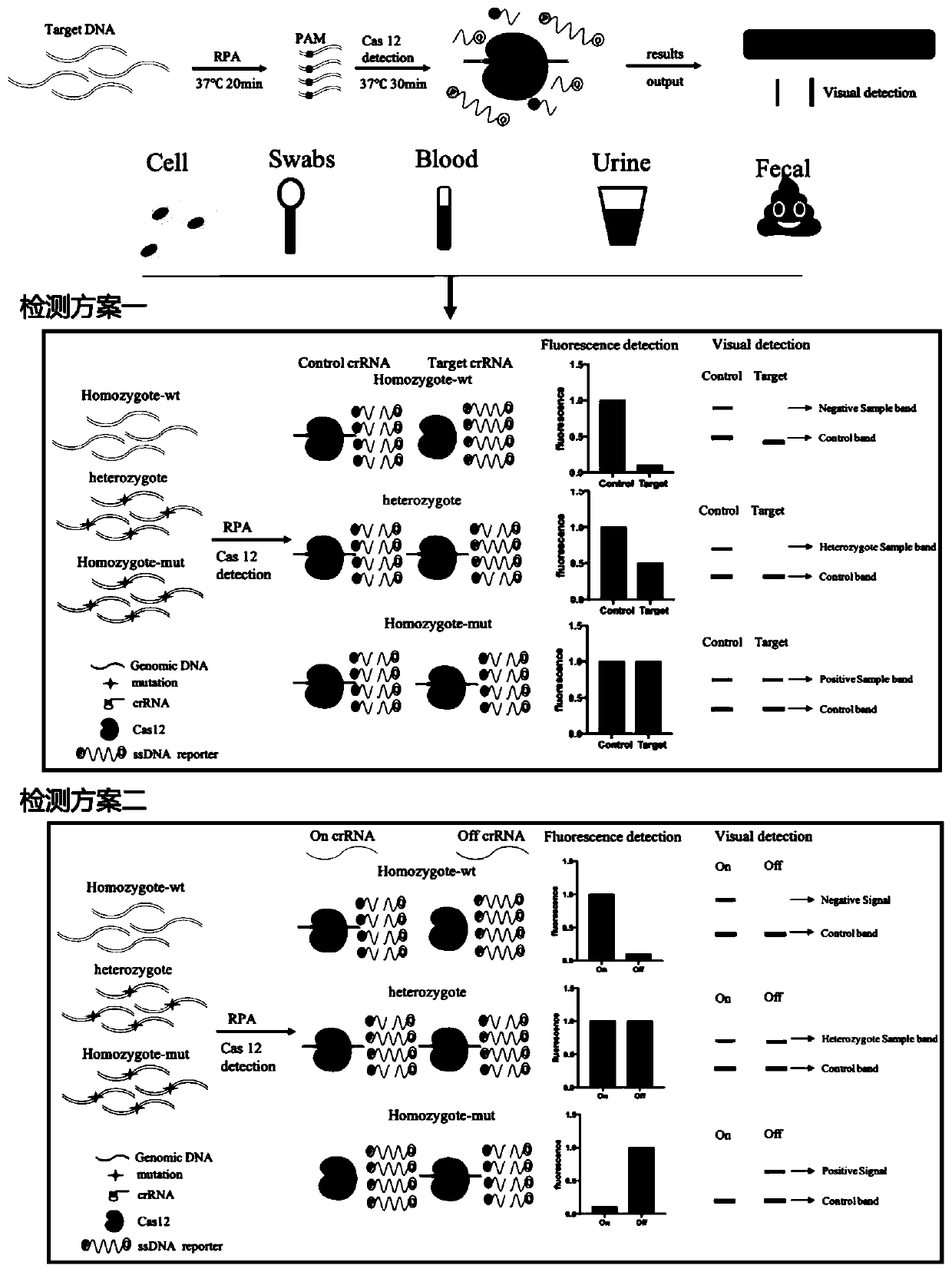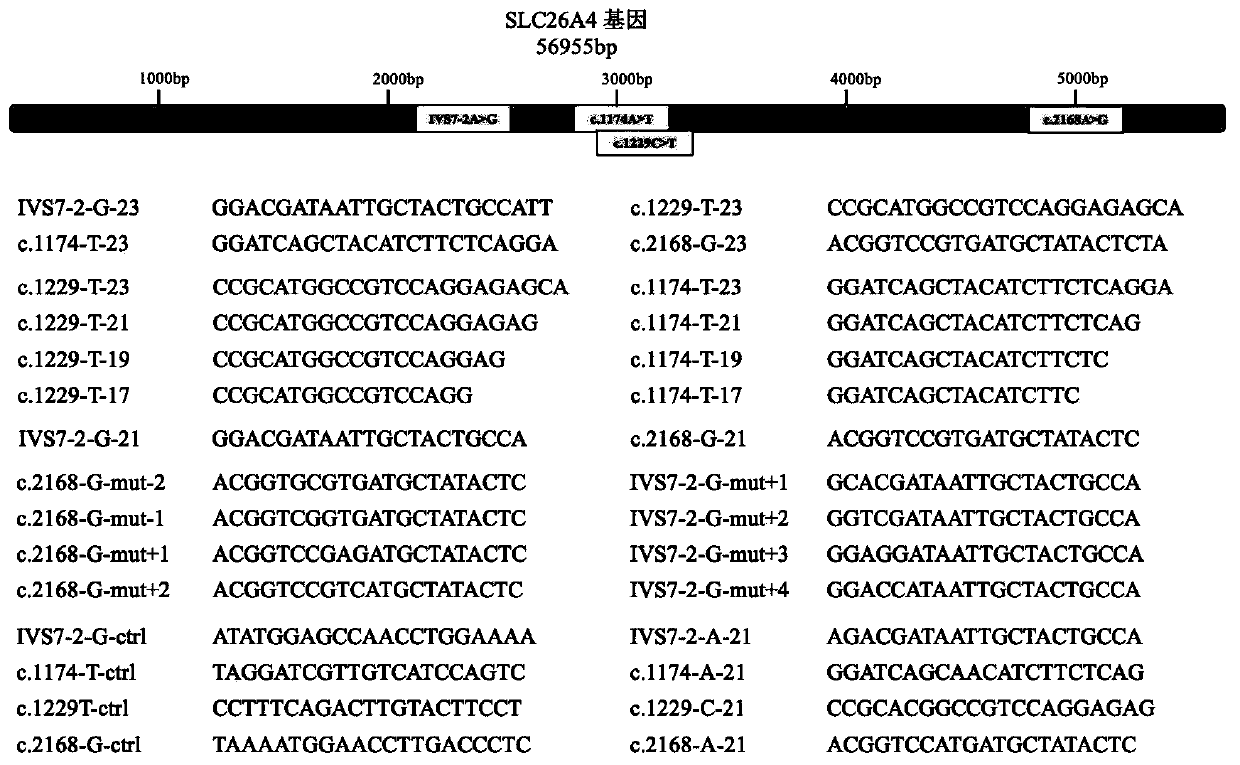Cpf1 kit for rapid detection of hereditary deafness pathogenic gene SLC26A4 mutation and detection method thereof
A technology of hereditary deafness and detection method, which is applied in the field of rapid detection method and detection kit for multiple mutation sites of SLC26A4 gene, can solve the problems of difficult data analysis, high sequencing cost, long detection time, etc., and achieves convenience and speed. The effect of result interpretation, high specificity and rapid visual detection
- Summary
- Abstract
- Description
- Claims
- Application Information
AI Technical Summary
Problems solved by technology
Method used
Image
Examples
Embodiment 1
[0041] Example 1: Rapid and sensitive detection of SLC26A4 gene mutation site fragments
[0042] 1.1 Nucleic acid preparation
[0043] In this case, the SLC26A2 gene fragment is based on the SLC26A4 gene sequence in the NCBI database. Amplification primers are designed according to each mutation site, and human genomic DNA is used as a template. After PCR amplification to obtain the target fragment, it is constructed by homologous recombination On the pUC57 vector, named respectively as pUC57-IVS7-2-A (SEQ NO.1), pUC57-IVS7-2-G (SEQ NO.2), pUC57-1174-A (SEQ NO.3), pUC57-1174 -T(SEQ NO.4), pUC57-1229-C(SEQ NO.5), pUC57-1229-T(SEQ NO.6), pUC57-2168-A(SEQ NO.7), pUC57-2168-> G (SEQ NO. 8). The amplification system is shown in Table 1.
[0044] Table 1. SLC26A4 Gene Mutation Site Fragment Amplification System
[0045]
[0046] The reaction system is as follows:
[0047]
[0048] After the sample is obtained, the next step of nucleic acid detection is carried out.
[00...
Embodiment 2
[0064] Example 2: Optimization of conditions for rapid detection of SLC26A4 gene fragments
[0065] The rapid detection of SLC26A4 gene mutation site is helpful to clearly judge the mutation in clinical samples, which is of great significance to the detection of early deafness. In this implementation case, taking the IVS7-2A>G, c.2168A>G, c.1229C>T and c.1174A>T sites of the SLC26A4 gene as an example, the Cpf1 detection kit of the present invention is used to demonstrate the pathogenicity of SLC26A4 Optimization of the detection conditions of the site.
[0066] Based on the fact that Cpf1 performs highly specific recognition and cleavage of the target sequence under the guidance of crRNA, a hypothesis is proposed: the shortening of the length of crRNA precisely paired with the SLC26A4 gene can lead to the inability of the Cpf1 cleavage system to efficiently recognize, which is manifested in the detection of fluorescence values at a certain level. The degree is reduced but ...
Embodiment 3
[0077] Example 3: Rapid and sensitive typing of a pair of SLC26A4 gene mutation sites using the protocol
[0078] Vestibular aqueduct enlargement / Pendred syndrome is an autosomal recessive genetic disease, and the typing detection of the mutation site of the causative gene SLC26A4 is helpful to clearly determine whether the clinical samples are normal people, mutation carriers or deaf patients. The detection of early deafness is of great significance. In this implementation case, taking the IVS7-2A>G site of the SLC26A4 gene as an example, the Cpf1 detection kit of the present invention is used to type the deafness pathogenic site.
[0079] Based on the fact that Cpf1 affects the cutting efficiency according to the degree of matching between crRNA and the target sequence, a hypothesis is put forward: select a suitable control sequence near the IVS7-2A>G site, transcribe it into IVS7-2-G-ctrl in vitro, and convert IVS7-2-G The detection signal of IVS7-2-G-ctrl is compared with...
PUM
 Login to View More
Login to View More Abstract
Description
Claims
Application Information
 Login to View More
Login to View More - R&D
- Intellectual Property
- Life Sciences
- Materials
- Tech Scout
- Unparalleled Data Quality
- Higher Quality Content
- 60% Fewer Hallucinations
Browse by: Latest US Patents, China's latest patents, Technical Efficacy Thesaurus, Application Domain, Technology Topic, Popular Technical Reports.
© 2025 PatSnap. All rights reserved.Legal|Privacy policy|Modern Slavery Act Transparency Statement|Sitemap|About US| Contact US: help@patsnap.com



